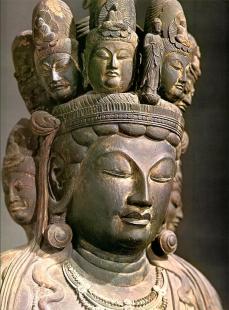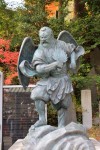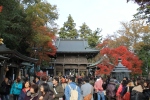Below is a presentation I recently gave at Keio University on the nine-headed dragon (Kuzuryū) of Mt. Togakushi. Sorry English readers (its mostly in Japanese). The title translated though, is “From narrative and ritual object to resident deity: Tracing the formation of the nine-headed dragon at Mt. Togakushi.” Textual passages are also translated into English and there’s a brief conclusion in English at the end.
この間、慶應義塾大学戸隠山の九頭龍について発表しました。レジメは以下の通りです。
説話・儀礼対象から地主神への変遷―戸隠山の九頭龍の形成をめぐって
第一 アジアにおける龍の信仰
一般的な特徴:水の管理(雨、災害など)、地主神、佛法の保護神、王権の象徴など
生息地(habitat):池、川、海、山、天
両面性の特性:
| 危険的 | 保護的 |
| 水に関する災害(大雨、洪水) | 雨を与える(水不足、農業などに対する) |
| 激しい・不安定的な状態 | 郷土、佛法、王権など |
佛教関係:
1)密教儀礼:雨乞い(rain-making rituals)、曼荼羅や印相(mudrā)などに関連する。
2)説話・物語:釈迦牟尼佛(Śākyamuni Buddha)の人生の物語を始め、法華経にある説話(八大龍王、龍王女の成る佛)、寺社の縁起などとよく結びついている。
日本の場合:
インド(nāga=龍)を始め、中国・朝鮮文化の佛教を通じて、龍・龍王信仰が日本に到達した。
最も早い出現:九世紀に、龍信仰が展開するとともに真言系の僧侶は密教儀礼を通じて龍王に雨を祈った。平安公家・貴族に対して、平安京にある天皇の御所近くの神泉苑や奈良県の室生寺を中心に善女龍王に関する縁起を造り、様々な密教的な雨乞いを行っていた。(Ruppert、2002年)
それ以降、全国では龍・大蛇・鬼などが徐々に各地の寺社(特に山の中心)の縁起に含められた。(内藤正敏氏、2009年)
第二 九頭を持つ龍(Nine-headed dragons)
佛教典:
- CBETA大正新脩大藏經(漢語で書かれたインドから中国・朝鮮に渡った佛典):「九頭龍」は34個の検索結果があった。
- SAT大正新脩大藏經(大正大藏經+日本の佛典):「九頭竜」・「九頭龍」は69個の検索結果があった。
- 法華經文献:法華經には、八大龍王が現れるが、九頭龍はその中ではない。その一方、以降の法華經に関する文献(論、義釋、伝記など)によく現れる。
- 中国の天台系:『法華傳記』(唐朝前半)、『止観輔行傳弘決』(8世紀)、『佛祖統紀』(1269年)など
*以上の中国で書かれたテキストは唐時代以降に著作される。そして多くの場合では、釋智璪という僧侶の伝記に結びついたが、寺社縁起とは関係なさそうである。
密教儀礼:
- 「九頭龍印」という印相:大日經文献、台密のテキスト(『行林抄』など)
- 曼荼羅に位置している:『法華曼荼羅威儀形色法經』、『胎藏入理鈔』など
- 雨乞い:『行林抄』1152 (仁平 2年)
日本における寺社縁起:
| 地名 | 最初の文献 | 文献年間 | 龍の漢字 | 関連する行者 | 関連する佛 | 宗 |
| 白山 | 『泰澄和尚伝記』 | 12世紀後半[2] | 九頭龍王 | 泰澄 | 十一面観音 | ? |
| 大峯(水天嶺) | 『大菩提山等縁起』 | 1152 (仁平 2年) | 九頭龍王 | 無 | 無 | 不明 |
| 箱根 | 『筥根山縁起并序』 | 1191 (建久2年) | 九頭毒龍 | 萬巻人 | 無 | 不明 |
| 阿蘇山 | 『彦山流記』 | 1213年 (建保1年) | 九頭八面大龍 | 臥驗 | 十一面観音 | 天台 ? |
| 戸隠山 | 『阿娑縛抄』 | 1279 (弘安2年) | 九頭一尾鬼 | 學問修行者 | 聖観音 | 天台 |
以上の縁起の共通点:
- ほとんどの縁起ではその龍が修行している行者の前に出現する。
- 観音菩薩と関連するケースが多い。九頭龍のように数多くの頭があるので、イメージ的に想像されたのか?
- 全部が山岳寺社の縁起である。
- 12世紀後半に九頭を持ち龍が突然に登場し、流行(龍行か?)していた。
- 九頭龍の名前はまだ既定されていない。むしろ「九頭」が名前よりも記述ではないか。
第三 縁起に現れる龍から地主神への変遷
資料1:「戸隠寺略記」、1279年(弘安2年)、『阿娑縛抄』、227巻の第200巻目の「諸寺略記上」、承澄編(1205–1282;延暦寺僧)
In 849 (Kashō 嘉祥 2), a learned practitioner (gakumon shugyō sha 學問修行者) spent seven days on Iizuna-san 飯縄山. Facing west toward a great peak, he prayed (kinen 祈念). He threw a single-armed sceptre (dokko 獨鈷?)[3] that took flight and then fell. He went to go see it. [It had landed] at a great stone cavern. At that site he chanted the Lotus Sūtra. During this time, a foul-smelling wind was exhaled from the south. A nine-headed, single-tailed oni (kuzu ichibi ki 九頭一尾鬼) arrived [and said,]
“Who chants the Lotus Sūtra? Even though I had no intention of harm (mugaishin 無害心), when I came to listen to those who recited it (chōmon 聽聞) in the past, they ended up dead after my noxious vapors reached them.
“I was the former administrator. I lived in greed and desire, carelessly using the donations of the faithful (shinse 信施). As a result, I received this body. This place has been destroyed and toppled down over forty times. I rely on the virtue (kōdoku 功徳) [of listening to you chant the Lotus Sūtra] and thus should able to attain awakening.”
Gakumon replied, “An oni hides its form.” Following these words, the oni returned to its original place. In that place, which is named “the dragon’s tail,” [the oni] entered into seclusion and sealed shut the door of the stone cavern.
From within the ground, a great voice chanted, “Take refuge in the assembly in which [I,] the honored Shō Kanjizai 聖観自在 [Shō Kannon] eternally reside; as a great avatar, [I] provide benefits to living beings at the three sites” (南無常住界會聖観自在尊三所利生大権現聖者).
This mountain is known as the temple of “the door [behind which one] hides” (Togakushi-ji 戸隠寺), because it conceals the dragon-tailed oni. The door of the stone cavern thus led to the establishment [of the temple]. It is also said that the from Mt. Iizuna, the [mountain’s] form resembles a door…
- 「學問修行者」というのは、おそらく人名ではなく、ただ学問や修行する人と指摘している(鈴木正崇氏、2013年、250–251頁)。という事は、当時、開祖という概念は薄いようである。
- 同じように(そして上記の5個の縁起のように)「九頭一尾鬼」というのも一般名称ではないか。
- この龍的な鬼が「前の別当」というのは、戸隠山の歴史を作ったが、良いイメージではない。鬼の存在をはじめに、現在の客姿格好は以前の悪い生活の業罰である。つまりこの段階では、九頭一尾鬼=主神というのはまだ微妙ではないか。
- 聖観音と九頭一尾鬼との関係は曖昧であり、神仏習合(本地垂迹)ははっきりしていない。
資料2:戸隠山顕光寺流記(並序)(以下『流記』と略す)、十穀僧有通編、1458年(長禄 2年)
英訳の節
There was a man known as Gakumon gyōja 學門行者. The mysterious profundity of his original nature (honji 本地) and his rank among the worthies (son’i 尊位) is difficult to estimate. He had accomplished all the practices. Embracing the bright moon, he ventured through the vast night. Replenished by the morning sun, he gazed in all directions (meiku 迷衢). His wisdom and practice was extremely great and his virtue and efficacy (in the magical arts) (tokugen 徳験) was superior in the world. He established a temple (garan 伽藍) in every land. He spread benefits (riyaku 利益) throughout the Dharma realm (hokkai 法界). It is said that his life ended by ascending into the sky without a burial. Thus he is regarded as the [response] body of the honored Śākyamuni and a sympathetic transformation (ōke 應化) of Kannon.
In the beginning, the gyōja said, “I want to restore [the practices of] this mountain.” In the middle of the third month of the third year of the Kashō 嘉祥 (850) era, under the reign of Emperor Ninmei 仁明 (810–850, r. 833–850), he began by climbing [the neighboring] Iizuna-san 飯縄山. [Iizuna] is a high marchmont that soars into the milky way (ginkan 銀漢)—its white summit contrasting the azure sky (hekiraku 碧落). Imprisoned (katai 牢) demons and ghosts (chimi 魑魅) crisscrossed [its slopes]. There was no trace of human paths. Inquiry into its ancient past [reveals that] it had never been scaled. The snow was deep and there were precipitous cliffs. Amidst the clouds, fog and thunder, he lost his way and was unable to ascend. He retreated to the midway point (hanpuku 半腹) [of the mountain]. As an offering to the various deities and spirits, he recited scriptures and chanted dhāraṇī (ju 咒). Tearing up [a section of] his robe (resshō 裂裳; Skt. bimbisāra), he wrapped his feet [with the cloth]. He was ready to discard his life and in his commitment to the way. Making a stern vow, he announced, “I humbly request that the benevolent deities [of this mountain] increase my power, that the heavenly dragons roll up the mist, and the mountain demons (sanmi 山魅) guide me. Please help me realize my goal! If I fail to reach the summit, I will not achieve awakening (bodai 菩提).”
Having produced such a vow, he treaded across the dazzling white snow and ascended [through] sparkling (saisan 璀璨) green leaves. Finally, exhausted and depleted of energy, he could see the summit. Appraising [his whereabouts], he [realized that he had] suddenly entered the Milky Way (unkan 雲漢). Foregoing a taste of this marvelous paradise, he found a divine cave. Elated and awestricken, he found it difficult to keep his mind (shinkon 心魂) tranquil.
For a short while, he gazed about the four directions. From the southeastern foot of the mountain, vast plains unfurled with grasses and trees (sōmoku 草木). Looking out in the distance, he saw the golden swells and silver whitecaps (ginpa 銀波) of a great, flowing river submerged in [i.e. reflecting the] azure sky. There was the faint wake of a crossing vessel. To the northwest were narrow and precipitous ravines and a long and hazardous [ridge line] of mountains laced in deep snow and flowers of the five colors (gosai 五彩). The birds cried out in cold (inkan 咽寒) throughout the day (rokuji 六時). The green canopies of thousand year-old pines and spruce tilted toward the valleys. Deep blue-colored [two-story] manors (konrō 紺樓), surrounded on all sides by cypress and mandarin trees (kaisō 檜楱), towered above the boulders. Gazing across [the entire vista], four mountains streams [are visible]. This divine splendor was vast.
Amidst an abundant sunset, [Gakumon] performed a divination in the western cave. He prayed and repented, “Now sitting on a cornelian seat in this practice site, having arranged incense and flowers [as an offering to the Buddha], and performing chants, I see myself as an śrāvaka (shōmon 聲聞). ” Then he hurled a vajra sceptre (kongō sho 金剛杵) and made the following vow: “From henceforth, may Buddha’s Law (Buppō 佛法) prosper and may living beings find fortune on the ground from where light emanates.”
Then flying [through the air], the mallet swiftly crossed a distance of over one hundred chō 町. A hunter was there. Frightened by the light of the mallet, he quickly fled and emerged [before Gakumon]. [Gakumon] received him and prepared to tell him about the event:
“I will inform [you] with these words: That hunting ground is now a hunting ground that defends the Dharma (gohō 護法).”
[Gakumon] went to go visit the light of the mallet. At the cave [where it landed], he wished to bring forth the resident deity (jinushi 地主). As he prayed (kinen 祈念), a voice came from the depths of the ground. The loud voice chanted,
“Take refuge in the eternally-abiding assembly of the realm: Shō Kanjizai 聖観自在 (Shō Kannon; Noble Avalokitêśvara) of Great Compassion and Sympathy and the origin bodies of the four sites. The avatars of the three sites radiate light and provide comfort” (南無常住界會大慈大悲聖観自在四所本躰、三所権現放光與樂). The voice ended by saying, “The light of Shō Kannon’s image radiates [Kannon’s] noble form from afar. From the luminous seats of a single lotus plant with four pedestals emerge (yūshutsu 湧出) Shō Kannon, Senjū 千手 [Kannon], Shaka 釋迦 (Skt. Śākyamuni), and Jizō 地蔵 (Skt. Kṣitigarbha).” As joyful tears streamed down, [Gakumon] lowered his head in deep devotion (katsugō 渇仰) and performed chants (hosse 法施) at the site.
That night a foul-smelling wind was exhaled from the south. A nine-headed, single-tailed dragon (kuzu ichibi ryū 九頭一尾龍) arrived and said,
“A joyous practitioner arrived at this cave, chanting and rattling (shindoku 振讀) his staff (shakujō 錫杖). By repenting the six root [senses] and practicing the four [types] of tranquility (shi anraku gyō 四安楽行), the poisonous vapors (dokuke 毒氣) have all been vanquished and there is no longer any obstructions (gai 害). You immediately receive me, [so] I will give you the full account (zengo 善語).
“This mountain has been destroyed over forty times. I have engaged in temple duties seven times. The last administrator, Chōhan 澄範, was me. Because I carelessly used the possessions of the Buddha (butsumotsu 佛物), I received this serpent-like body (jashin 蛇身). From many eons up until the present, I have been hindered by the karma (gōshō 業障) of these [dragon] scales (uroko 鱗). I arose when I heard [your] staff and [chanting] Dharma voice (hōon 法音) and obtained liberation (gedatsu 解脫). You must maintain an awakened state of mind (bodai shin 菩提心) and quickly build a great temple (garan 伽藍; Skt. saṃgha-ārāma).”
阿娑縛抄と比較すると、戸隠山の開祖や地主神の輪郭が完全に創られた。
- 一般的な「学問」を名前の「学門」と取替え、彼の伝記も創造され、修行や活動を詳しく伝える。
- 竜的な「鬼」から「地主」の「九頭一尾龍」になる。
- 九頭龍の話の内容は『阿娑縛抄』の話と非常に似ているが、『流記』に入っている以上の節の後に「九頭権現」や「九頭龍権現」と呼ばれる。その節では、「九頭権現」の多彩的な特徴や利益が詳しく説明される。その中で、大辨功徳天(弁財天)の垂迹になったり、佛性や世尊の智恵を持ったり、色々な現世利益を与えたり、法華経である龍女に成ったりしている。しかし気になるのは、その長い話の中では、水神としての説明は一切現れない。その一方、江戸時代に渡って雨乞い、瀬引き、出水の祈禱のような儀礼が密接に結びついていく。そしてその時代になるとともに戸隠山の九頭龍が全国に広がり、その結果、戸隠の代表的な特徴になる。
終りに
九頭龍が戸隠山に到達する前、中国の唐・宋朝や日本の鎌倉時代初期に様々な説話や密教儀礼で流行しているが、当時の存在は以外に抽象的であり、地主神とは言い難い。しかし戸隠山の例を挙げると、時代が流れ徐々に地元の地主神に変遷する事が分かる。
その過程では、文学や密教の世界に入っていた抽象的な物が具体的な神に変化した。その両面性は、幅広い(東アジアの)思想・儀式が各地に到達すればするほど地元的な神に変形される。特殊な神になると同時に、その場所の霊性や名声が発生するのではないか。
(Before its arrival to Togakushi and other sites around the Japanese archipelago, the nine-headed dragon in East Asia exists among esoteric rituals and legendary anecdotes. In this realm, Kuzuryū is situated in the abstract, detached from place and identity. Its title remains more descriptive than nominal. Only when the dragon arrives and gains traction at a specific sites such as Mt. Togakushi does it evolve into concretized deity, Kuzuryū. This residence and ‘precipitation’ of benefits at the mountain simultaneously becomes instrumental in the production of Mt. Togakushi, itself, as a respected numinous and powerful site.)
文献
Bloss, Lowell W. 1973. “The Buddha and the Nāga: A Study in Buddhist Folk Religiosity.” History of Religions 13, no. 1: 36–53.
Chinese Buddhist Electronic Text Association (CBETA).
Cohen, Richard S. 1998. “Nāga, Yakṣiṇī, Buddha: Local Deities and Local Buddhism at Ajanta.” History of Religions 37, no. 4: 360–400.
Hayashi Minao 林巳奈夫. 1993. Tatsu no hanashi: Zuzō kara toku nazo 龍の話 : 図像から解く謎. Tōkyō: Chūō Kōronsha 中央公論社.
Hongō Masatsugu 本郷真紹. 2001. 『白山信仰の源流』. Kyōto: 法蔵館.
Ikegami Shōji 池上正治. 2000. 『龍の百科』. Tōkyō: 新潮社.
Naitō Masatoshi 内藤正敏. 2009. 「戸隠山の鬼―都市の異界と山の異界」. 『江戸・都市の中の異界』. 民俗の発見 IV. Vol. 4: 271–311. 法政大学出版局.
Ruppert, Brian O. 2002. “Buddhist Rainmaking in Early Japan: The Dragon King and the Ritual Careers of Esoteric Monks.” History of Religions 42, no. 2: 143–174.
Suzuki Masataka 鈴木正崇. 2013. 「中世の戸隠と修験道の展開―『顕光寺流記』を読み解く」. 『異界と常世』. Pp. 239–330. 楽瑯書院.
Visser, M. W. de. 1969 (1913). The Dragon in China and Japan. Wiesbaden: Sändig.
Yoshida Kazuhiko 吉田一彦. 2012. 「宗叡の白山入山をめぐって:九世紀における神仏習合の展開(一)」. 『佛教史研究第五〇号抜刷』.
























